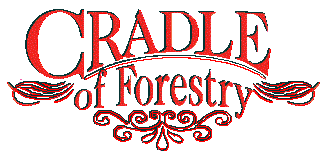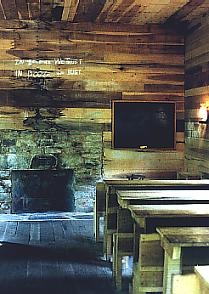
The Birth Place of Forestry In America
| WEATHER | | | CALENDARS | | | ADVENTURES | | | TRAVELS | | | MUSIC | | | COUPONS | | | BOOKS | |||||||
|
Pisgah
National Forest
Cradle of Forestry - Biltmore Campus Trail
|
|||||||||||||||||||
Thanks for joining us on the Biltmore Campus Trail virtual hike- one of the only hikes you can take without moving your feet.

The Birth Place of Forestry In America
In the 1800's the area encompassed by the Pisgah Ranger District was in private hands. The site of the Cradle of Forestry was the site of a small settlement of independent mountain folks, called Pink Beds. Unfortunately, by the end of the 1800's, the land was suffering heavily from abuse and over-farming.
George W. Vanderbilt, who was buying land in the area for his Biltmore House estate in Asheville, asked his forest manager, Guifford Pinchot, if he should buy the area of Pisgah Forest that had been offered for sale to him. Pinchot enthusiastically replied yes and the purchase became a 125,000 acre preserve that eventually became part of the National Forest.
Frederick Law Olmstead, landscape architect for Vanderbilt, suggested the hiring of Pinchot to help restore the forests of Biltmore, which like Pisgah Forest had been ravaged by careless land use. Pinchot was one of the first people in America to start thinking about forest health and management issues. Teddy Roosevelt shortly after appointed Pinchot to the office of Chief of the Division of Forestry under the US Department of Agriculture, which later became the USDA Forest Service. Pinchot suggested the German, Carl Schenck, to be his replacement. Schenck came to America with something unheard of in America at the time - a degree in forestry.
The first stop on our virtual hike is at The Schoolhouse.
 The "Campus" at Biltmore Forest School consisted of mountaineer cabins
and farm homes which once had been part of the old "Pink Beds" community.
The one room community school and church became the forestry school's classroom.
The "Campus" at Biltmore Forest School consisted of mountaineer cabins
and farm homes which once had been part of the old "Pink Beds" community.
The one room community school and church became the forestry school's classroom.
Occassionally Schenck preached at the church and even bought an organ to "improve the singing". He said, "singing is the best peacemaker". Schenck brought his "boys", as he called his students, here each spring for about 6 months. He lectured mornings and after luch led the students to the field to demonstrate practical applications of his theories.
Alumni of the Biltmore Forest School donated funds to have the school building reconstructed in 1966.
 Dr. Carl Schenck set up his operations in the area in 1898, where the Cradle
of Forestry now stands. The school of forestry that he began was the first in
America. Schenck opened his school to local boys and men and began teaching
wise-use forest management practices that included selective tree cutting and
thinning, pest and disease monitoring, erosion controls in forested areas and
management practices that were less impactful to adjacent areas. He had to write
his own textbooks because none existed before. Also, since he was a German and
not familiar with all of the American trees, he experimented with different
species in the schools' tree nursery to discover which ones would grow the best.
Thanks to the wisdom and foresight and hard work of Schenck, Pinchot, Olmstead
and Vanderbilt, the Pisgah Forest area is today in much healthier shape than
it was at the turn of the this century. Practices established here have been
successfully employed in many parts of the world.
Dr. Carl Schenck set up his operations in the area in 1898, where the Cradle
of Forestry now stands. The school of forestry that he began was the first in
America. Schenck opened his school to local boys and men and began teaching
wise-use forest management practices that included selective tree cutting and
thinning, pest and disease monitoring, erosion controls in forested areas and
management practices that were less impactful to adjacent areas. He had to write
his own textbooks because none existed before. Also, since he was a German and
not familiar with all of the American trees, he experimented with different
species in the schools' tree nursery to discover which ones would grow the best.
Thanks to the wisdom and foresight and hard work of Schenck, Pinchot, Olmstead
and Vanderbilt, the Pisgah Forest area is today in much healthier shape than
it was at the turn of the this century. Practices established here have been
successfully employed in many parts of the world.
Winter classes were held at Biltmore Estate near Asheville and summer sessions in Pisgah Forest. The school operated on a 12 month basis and a young man could start at the beginning of any of the various lectures. Schenck had a favorite greeting for new students..."Join us and sink or swim".
He also said that no student could hope to be successful at Biltmore unless he was willing to devote all of his time and all of his energy to study-- in the classroom, in the field, and in his room.